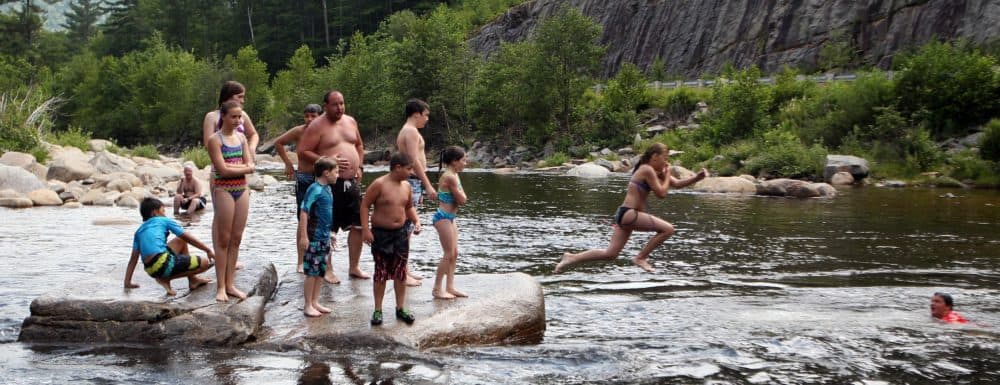Advertisement
How to make sure cyanobacteria doesn't spoil your swimming plans

Cyanobacteria season is in full swing in New England. And rising temperatures means those blooms have more of a chance to thrive during a longer cyanobacteria season.
These blooms produce cyanotoxins that can be harmful to both humans and animals. According to the Centers for Disease Control and Prevention, they can cause symptoms ranging from abdominal pain to numbness.
Cyanobacteria is one of several kinds of bacteria state officials monitor in New Hampshire waters.
But Jessica Volan Trout-Haney, who investigates cyanobacteria with the Lake Sunapee Protective Association, said what makes cyanobacteria unique is its origin. Unlike E. coli — which usually comes from fecal matter of wildlife, pets, or even people — she said cyanobacteria occur naturally, growing from nutrients in the waters' food chain.
There are steps you can take to protect yourself, your loved ones and even your pets from cyanobacteria. Here's how.
1. Watch the weather.
New Hampshire Lakes President Andrea LaMoreaux said it’s important to know what to look out for when getting ready to swim in a lake or pond.
Recent testing has shown that heavy rains can increase the cyanobacteria level, and LaMoreaux said jumping into the water after a big storm isn’t the best idea.
“That's generally when you're going to have pollution or waste washing into our water bodies,” she said.
This is a concern because water runoff could include animal waste, fertilizer or septic system waste. When that happens, LaMoreaux said, it can make both cyanobacteria and E. coli grow.
“So certainly there is a connection between increased toxic cyanobacteria in our lakes and in the changing weather," she said. "And I would definitely think there is the potential for increasing E. coli."
New Hampshire is expected to see more extreme precipitation events due to climate change.
Advertisement
2. Check for advisories.
You can look up cyanobacteria advisories on the New Hampshire Department of Environmental Services website. Massachusetts also posts similar advisories.
When arriving somewhere to swim, LaMoreaux said the first thing you should do is look for any signs posted in the area warning of cyanobacteria. It's normal to find some levels of any bacteria and algae in the water, but some levels are too dangerous for people and pets.
“If you go to a public beach, see if there's a sign posted," she said. "If a public beach has had a high level rating, they will post a sign, an advisory sign. But short of that, not all of our not all of our beaches are tested all the time.”
3. Look before you leap.
If you arrive at a swimming spot without a sign or cyanobacteria advisory posted, still make sure to pay close attention to the waters before you dive in.
If the water looks a weird color or smells odd or fishy, LaMoreaux recommends not going in. New Hampshire has 12 different cyanobacteria species, and they can all look different. She suggested looking out for water that has green, blue, white or red hues.
But don't just pay attention to the water. You should also be mindful of what wildlife is nearby.
Many animals defecate in the same waters that they swim in. If you see a lot of ducks or geese around, LaMoreaux said, "you probably don't want to leap into the water right there."
“If you see a bunch of geese hanging around or waterfowl hanging around, you know you're probably not going to swim, right?" she said.
Summer storms can also wash waste from both pets and wildlife into the water. And with warmer water temperatures, she said, “that makes sort of like ideal grounds for bacteria and E coli to grow.”
4. Take a quick rinse, post-dip.
As a mother, LaMoreaux said she follows the same advice she gives.
“I have a kiddo, too," she said. "And I always say after we go to the lake, make sure to shower off afterwards just to be safe.”
This story is a production of New England News Collaborative. It was originally published by New Hampshire Public Radio.